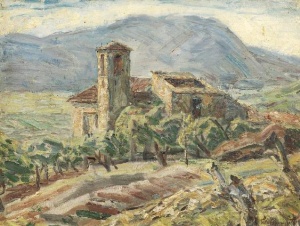Difference between revisions of "Wohlgemuth, Daniel (1876-1967)"
| [checked revision] | [checked revision] |
m (Added categories.) |
SusanHuebert (talk | contribs) m |
||
| Line 1: | Line 1: | ||
[[File:Wohlgemuth.jpg|300px|thumb|right|''Im Reiche der Circe by Daniel Wohlgemuth<br /> | [[File:Wohlgemuth.jpg|300px|thumb|right|''Im Reiche der Circe by Daniel Wohlgemuth<br /> | ||
Source: [http://www.artnet.com/artist/579134/daniel-wohlgemuth.html Artnet]'']] | Source: [http://www.artnet.com/artist/579134/daniel-wohlgemuth.html Artnet]'']] | ||
| − | Wohlgemuth, Daniel (1876-1967), a son of Johannes Wohlgemuth of Albisheim | + | Wohlgemuth, Daniel (1876-1967), a son of Johannes Wohlgemuth of Albisheim an der Pfrim and Katharina (Krehbiel) Wohlgemuth of [[Weierhof (Rheinland-Pfalz, Germany)|Weierhof]], was born at Albisheim 17 April 1876, but reared by his uncle Johannes Krehbiel of Weierhof, studied art at Frankfurt and Strasbourg, and finally at the Art Academy in Munich under Franz von Stuck. His travels in Italy, Palestine, and Russia contributed to his development. His artistic work was done chiefly in his native Rhenish Hesse and the [[Palatinate (Rheinland-Pfalz, Germany)|Palatinate]] (for a time living at Weierhof, later at Gundersheim near Worms), but also for a time in Munich and Berlin. His chief medium was black and white drawing, including charcoal (often lithographs) but also water colors and oils. His themes were largely landscapes, often of his native land, with a fine series on Palestine. He also did many portraits, including an excellent one of Albert Schweitzer. His works are found in all the leading German galleries, such as Munich, Stuttgart, Karlsruhe, Mannheim, Frankfurt, Dresden, Berlin, Homburg, and Leipzig. During his lifetime he received acclaim by leading art critics. |
= Bibliography = | = Bibliography = | ||
Händiges, Martha. "Palästinabilder eines mennonitischen Malers." <em>Mennonitische Jugendwarte. </em>Ludwigshaten, Germany, 1921: No. 4, 18-23; 1823. | Händiges, Martha. "Palästinabilder eines mennonitischen Malers." <em>Mennonitische Jugendwarte. </em>Ludwigshaten, Germany, 1921: No. 4, 18-23; 1823. | ||
Latest revision as of 18:17, 16 November 2016
Wohlgemuth, Daniel (1876-1967), a son of Johannes Wohlgemuth of Albisheim an der Pfrim and Katharina (Krehbiel) Wohlgemuth of Weierhof, was born at Albisheim 17 April 1876, but reared by his uncle Johannes Krehbiel of Weierhof, studied art at Frankfurt and Strasbourg, and finally at the Art Academy in Munich under Franz von Stuck. His travels in Italy, Palestine, and Russia contributed to his development. His artistic work was done chiefly in his native Rhenish Hesse and the Palatinate (for a time living at Weierhof, later at Gundersheim near Worms), but also for a time in Munich and Berlin. His chief medium was black and white drawing, including charcoal (often lithographs) but also water colors and oils. His themes were largely landscapes, often of his native land, with a fine series on Palestine. He also did many portraits, including an excellent one of Albert Schweitzer. His works are found in all the leading German galleries, such as Munich, Stuttgart, Karlsruhe, Mannheim, Frankfurt, Dresden, Berlin, Homburg, and Leipzig. During his lifetime he received acclaim by leading art critics.
Bibliography
Händiges, Martha. "Palästinabilder eines mennonitischen Malers." Mennonitische Jugendwarte. Ludwigshaten, Germany, 1921: No. 4, 18-23; 1823.
Illert, Friedrich M. Daniel Wohlgemuth: An seinem 80. Geburtstag. Worms, 1956.
Krahn, C. "Daniel Wohlgemuth - An Artist of Bible Lands." Mennonite Life IX (1954): 4-6.
| Author(s) | Cornelius Krahn |
|---|---|
| Date Published | 1959 |
Cite This Article
MLA style
Krahn, Cornelius. "Wohlgemuth, Daniel (1876-1967)." Global Anabaptist Mennonite Encyclopedia Online. 1959. Web. 16 Apr 2024. https://gameo.org/index.php?title=Wohlgemuth,_Daniel_(1876-1967)&oldid=140876.
APA style
Krahn, Cornelius. (1959). Wohlgemuth, Daniel (1876-1967). Global Anabaptist Mennonite Encyclopedia Online. Retrieved 16 April 2024, from https://gameo.org/index.php?title=Wohlgemuth,_Daniel_(1876-1967)&oldid=140876.
Adapted by permission of Herald Press, Harrisonburg, Virginia, from Mennonite Encyclopedia, Vol. 4, p. 969. All rights reserved.
©1996-2024 by the Global Anabaptist Mennonite Encyclopedia Online. All rights reserved.

